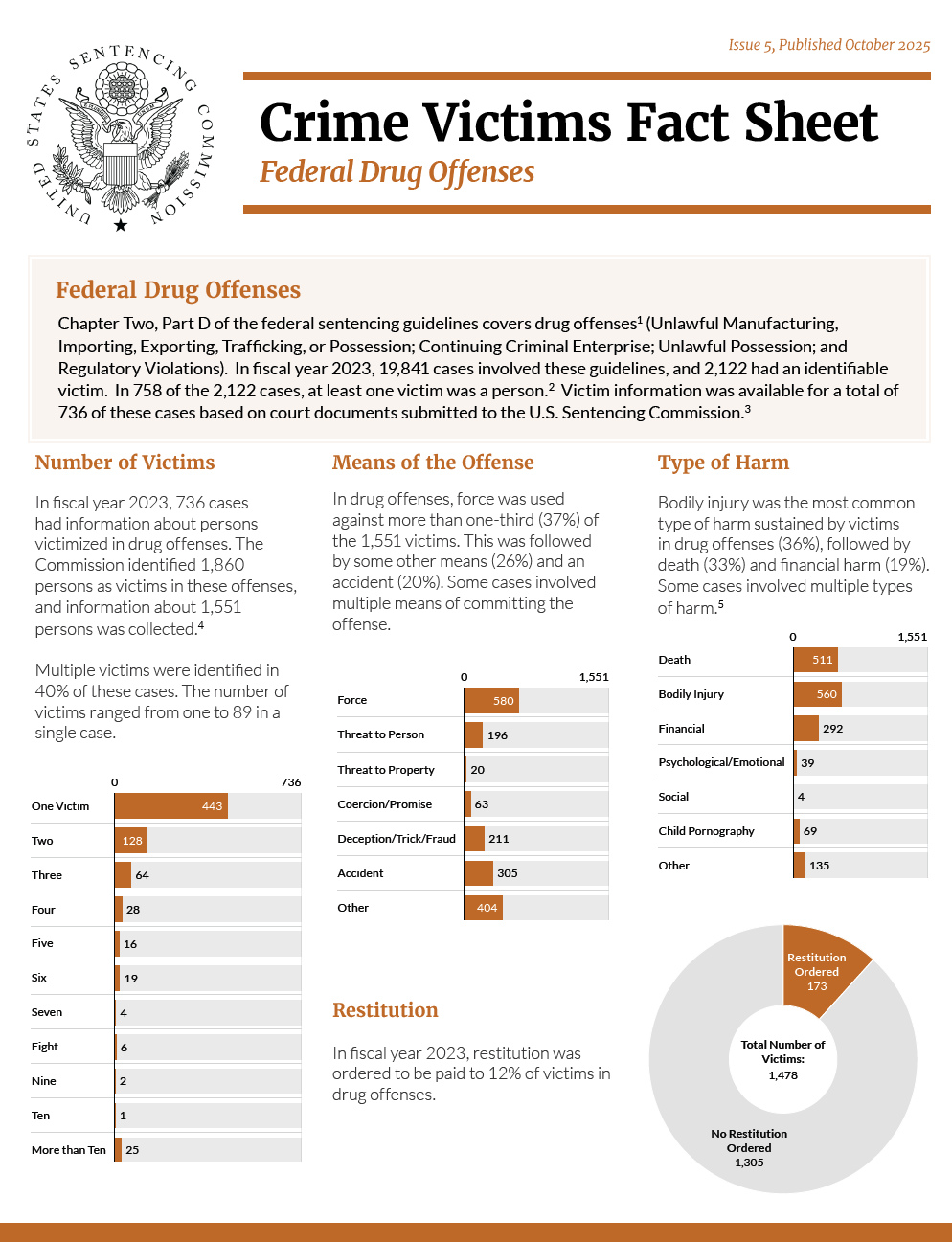CRIME VICTIMS FACT SHEET
Federal Drug Offenses
Chapter Two, Part D of the federal sentencing guidelines covers drug offenses1 (Unlawful Manufacturing, Importing, Exporting, Trafficking, or Possession; Continuing Criminal Enterprise; Unlawful Possession; and Regulatory Violations).
In fiscal year 2023, 19,841 cases involved these guidelines, and 2,122 had an identifiable victim. In 758 of the 2,122 cases, at least one victim was a person.2 Victim information was available for a total of 736 of these cases based on court documents submitted to the U.S. Sentencing Commission.3
Click the button for a PDF or learn more below.
NUMBER OF VICTIMS
In fiscal year 2023, 736 cases had information about persons victimized in drug offenses. The Commission identified 1,860 persons as victims in these offenses, and information about 1,551 persons was collected.4
Multiple victims were identified in 40% of these cases. The number of victims ranged from one to 89 in a single case.
MEANS OF THE OFFENSE
In drug offenses, force was used against more than one-third (37%) of the 1,551 victims. This was followed by some other means (26%) and an accident (20%). Some cases involved multiple means of committing the offense.
TYPE OF HARM
Bodily injury was the most common type of harm sustained by victims in drug offenses (36%), followed by death (33%) and financial harm (19%). Some cases involved multiple types of harm.5
RESTITUTION
In fiscal year 2023, restitution was ordered to be paid to 12% of victims in drug offenses.
RELATIONSHIPS BETWEEN VICTIMS AND INDIVIDUALS WHO CAUSED HARM
In drug offenses, the most common association between victims and the individuals who caused them harm was as a stranger (30%). The next most common were as a customer or client (23%) or an acquaintance (22%). Some cases involved multiple relationship types.
64% of victims in drug offenses were harmed by more than one individual.
VULNERABILITY
Some drug offenses involved victims who were unusually vulnerable due to age, physical or mental condition, or other factors.6 The Commission identified 16% of victims in these cases as unusually vulnerable for one of these reasons. Some cases involved multiple vulnerabilities.
VICTIM CHARACTERISTICS
Almost one-quarter (23%) of victims in drug offenses were juveniles.
One-third (33%) of victims in drug offenses were female.
ENDNOTES
1 Federal Drug Offenses include individuals sentenced in fiscal year 2023 in cases involving USSG §§2D1.1 (Unlawful Manufacturing, Importing, Exporting, or Trafficking (Including Possession with Intent to Commit These Offenses); Attempt or Conspiracy); 2D1.2 (Drug Offenses Occurring Near Protected Locations or Involving Underage or Pregnant Individuals; Attempt or Conspiracy); 2D1.5 (Continuing Criminal Enterprise; Attempt or Conspiracy); 2D1.6 (Use of a Communication Facility in Committing Drug Offense; Attempt or Conspiracy); 2D1.8 (Renting or Managing a Drug Establishment; Attempt or Conspiracy ); 2D1.10 (Endangering Human Life While Illegally Manufacturing a Controlled Substance; Attempt or Conspiracy); 2D1.11 (Unlawfully Distributing, Importing, Exporting or Possessing a Listed Chemical; Attempt or Conspiracy); 2D1.12 (Unlawful Possession, Manufacture, Distribution, Transportation, Exportation, or Importation of Prohibited Flask, Equipment, Chemical, Product, or Material; Attempt or Conspiracy); 2D2.1 (Unlawful Possession; Attempt or Conspiracy); 2D2.2 (Acquiring a Controlled Substance by Forgery, Fraud, Deception, or Subterfuge; Attempt or Conspiracy); 2D3.1 (Regulatory Offenses Involving Registration Numbers; Unlawful Advertising Relating to Scheduled Substances; Attempt or Conspiracy); or 2D3.2 (Regulatory Offenses Involving Controlled Substances or Listed Chemicals; Attempt or Conspiracy). Multiple sentencing guidelines may have been applied in these cases, including some not listed above.
2 An identifiable victim can be a person, business, government, or other type. This series provides victim information on persons.
3 The Commission’s Crime Victims Fact Sheets series relies on information collected and analyzed through a special coding project undertaken by the Commission to gather information beyond what is regularly collected and reported on by the Commission.
4 The sentencing documents received from the courts by the Commission are often focused on the sentencing event; therefore, some information regarding the victims of the offense was not provided in the documents available for staff review. For this reason, the total number of cases with complete information, and the corresponding number of victims in those cases, will vary by analysis. Victim information was collected for the first ten persons documented in the records.
5 In a small number of cases, the type of harm resulted from additional counts of conviction for offenses other than the ones discussed in this fact sheet. All of the harm types involved in a case are reported in this fact sheet.
6 In some, but not all, of these cases the court applied the adjustment at USSG §3A1.1. Vulnerability due to advanced age or youthfulness was determined by the offense conduct stated in the presentence investigation report adopted by the court, and not based on any minimum or maximum age.
SOURCE: U.S. Sentencing Commission, 2023 Victim Datafile, VICFY23.

